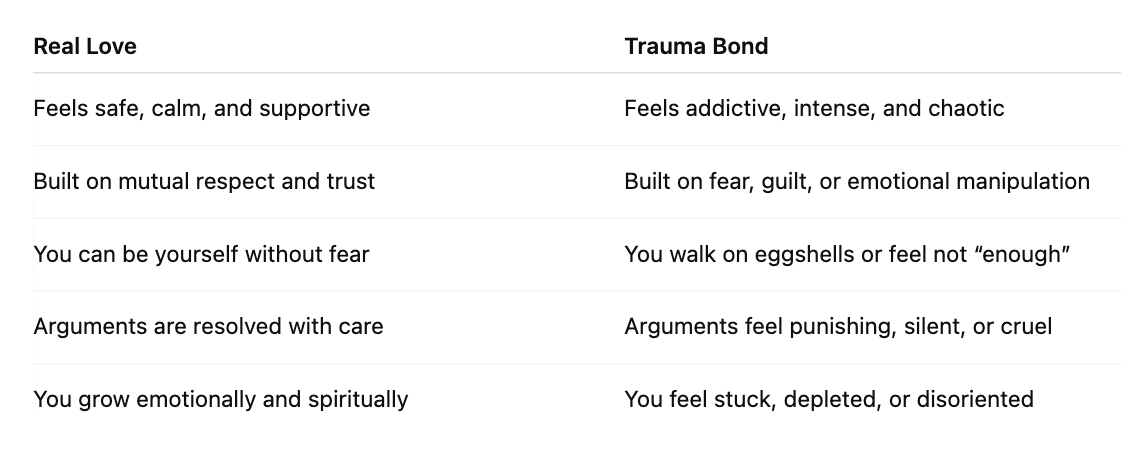Modern Love Unfiltered: Series 6
Are you in love — or stuck in a trauma bond? In this eye-opening entry of the Modern Love Unfiltered series, Sofia Winters breaks down the subtle but powerful difference between healthy love and trauma-based attachment. Using real therapist insights and trauma psychology, this article guides readers through how trauma bonds form, why they’re hard to leave, and the step-by-step healing strategies to break free. If you’ve ever felt addicted to someone who keeps hurting you, this post is the beginning of your emotional freedom. Discover the difference between real love and trauma bonding, and learn how to heal from toxic emotional attachment with therapist-backed tools and emotional clarity.
RELATIONSHIP LOVE SERIES
Sofia Winters
5/2/20253 min read


Is It Love or a Trauma Bond? The Subtle Difference Most People Miss
When Intensity Feels Like Chemistry — But Leaves You Broken
You feel deeply connected.
You’ve never felt a pull this strong.
You can't stop thinking about them, even when the relationship is clearly hurting you.
You tell yourself it's love… but is it really?
Here’s the truth: Not all strong emotional connections are healthy.
Sometimes, what we mistake for “soul-deep love” is actually a trauma bond — a powerful attachment formed through emotional chaos, control, and unpredictable reinforcement.
In this post, we’ll unpack what trauma bonding really is, how it forms, how to tell it apart from genuine love, and most importantly — how to break free and heal.
What Is a Trauma Bond?
Trauma bonding is a psychological response that occurs when the brain forms an emotional connection to someone who is causing harm or inconsistency — usually through a cycle of affection and abuse, reward and punishment.
According to therapist Dr. Patrick Carnes, who coined the term, trauma bonds are often created in relationships with intermittent reinforcement — meaning love and approval are given inconsistently, keeping the partner constantly off-balance and emotionally dependent (Carnes, 1997).
This bond feels intense because it activates survival responses — not because it’s rooted in mutual love, safety, or respect.
Real Love vs. Trauma Bonding: A Side-by-Side Comparison
➡️ If you often feel addicted to a person’s presence and deeply anxious during their absence — chances are, you’re in a trauma bond, not a love story.
Why Trauma Bonds Are So Hard to Leave
🧠 Your brain is chemically hooked: The cycle of highs and lows floods your body with
cortisol and dopamine — mimicking addiction.
👶 Your attachment wounds are triggered: Childhood experiences of neglect,
emotional inconsistency, or conditional love get reenacted.
😔 You confuse pain with passion: Your nervous system has mistaken
survival mode for emotional connection.
5 Steps to Break the Trauma Bond and Reclaim Yourself
✅ 1. Be Honest with Yourself
Ask: Does this love nourish me or drain me?
Make a list of how you feel during and after interactions — clarity comes from patterns.
✅ 2. Practice No Contact or Low Contact
Limit exposure to people who confuse your emotions — even if they apologize. Emotional clarity needs space.
✅ 3. Reconnect With Safe Love
Build emotional safety through therapy, community, spiritual guidance, or healthy friendships. You can't heal in isolation.
✅ 4. Try Trauma-Informed Therapy
Modalities like IFS (Internal Family Systems), EFT (Emotionally Focused Therapy), or Somatic Experiencing help process and unhook trauma responses.
✅ 5. Reprogram Your Nervous System
Use body-based practices like yoga, grounding, and vagus nerve exercises to calm your emotional state and develop a new baseline for peace.
Healing Is Not About Going Back — It’s About Becoming Whole
You don’t owe loyalty to a connection that’s rooted in pain.
You deserve to be loved without conditions, confusion, or emotional games.
And real love — the kind that stays, grows, and heals — doesn’t leave you guessing.
Breaking a trauma bond isn’t about being stronger. It’s about becoming wiser, softer, and more attuned to what love should truly feel like: Safe. Steady. Sacred.
You are allowed to walk away from what wounds you — even if it once felt like home.
With fierce compassion,
Sofia Winters
📚 Cited Sources:
Carnes, P. (1997). The Betrayal Bond: Breaking Free of Exploitive Relationships. Health Communications Inc.
Thomas, S. (2016). Healing from Hidden Abuse: A Journey Through the Stages of Recovery from Psychological Abuse. South Main Media.
Fisher, H. et al. (2005). Romantic love and the brain. Journal of Comparative Neurology, 493(1), 58–62.






Explore
Your ultimate lifestyle hub for inspiration and tips.
Connect
Subscribe
© 2025. All rights reserved.
OnBlogz. Smart Living. Smarter Choices
Designed by ABC Global Solutions
